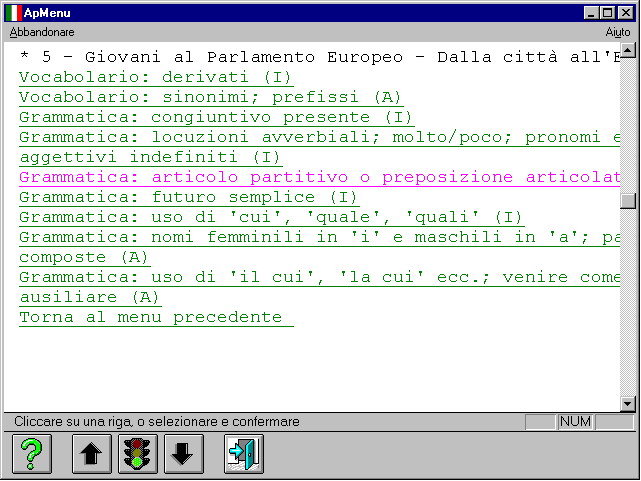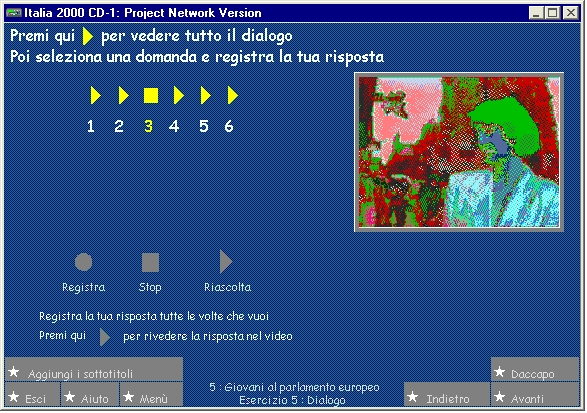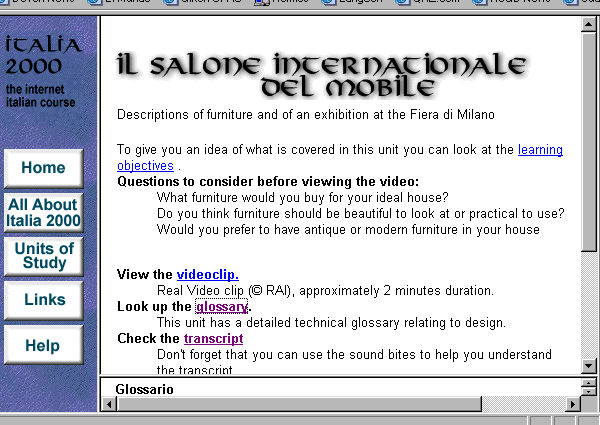
italia2000
sections on this page:
other pages on this site:
- Home
- Archive de Textes
- Liens utiles
- Textes électroniques
- Italia 2000
- Images: Cambridge
- Images: France
- Bibliographie
The screendumps have been highly compressed and are therefore of poor quality. The real things doesn't look quite this bad! It is also worth being aware that the video clip shown in the CD-ROM section has been mis-coloured.
floppy disk version.

This program sees the computer working as a tool. Its purpose seems to be simply for testing grammar and it succeeds in doing this very well. It may be used both in the classroom or for more private study, although the cost and the licensing arrangments would seem to preclude any non-institutional ownership of the software. The floppy disk version does not really appear to do anything that older software would not have done before, but the key is that it forms part of a set of resources on video and CD-Rom and the material studied on the floppy disk relates to these other resources. This, in turn, begs the question: 'Are the twelve floppy disks involved really needed?' The answer to this must surely be 'no', for the CD-ROM can also hold the video that it refers to and it is certainly not value-for-money to use the course without the CD-ROM version as well. That said, the floppy disks appear to have been included for the many schools which, at the time of production in 1997/8, were still using RISC-PCs, and which could only just cope with emulating Windows 3.1 Because the system requirements of the floppy disk version are so low, it would probably work well based on an Acorn RISC-PC network.
The layout and design of the software could certainly be improved. It appears to have been designed along the lines of much contemporary Windows 3.1 software and certain things, such as the use of the green traffic light would take some users today much time to get used to, although this was a more standard idea under Windows 3.1. Text is easy-to-read, being persented in green on a white background, although this may not be suitable for partially-sighted users. A pink colour is used for selected text and this is hard to read as the leevel of contrast with the background is low. The layout must, however be commended in that there are actually two programs used - ApMenu.exe and Lacuna.exe - but the appearance has been kept consistant between them. As far as navigation is concerned, it is possible to quit any activity at any time and also to choose any activity out of sequence.
Context-sensitive help is available in the old-standard Windows format (ie non-HTML-based), so the help is easy to browse for anybody who has used a Windows-based help before.
The floppy disk version does not really add anything to the package overall, however, since all of the exercises could just as easily be done on paper (although this would increase teacher marking times!). The exercises are all fairly standard, old-fashioned, grammar excerises but have been designed such that only one answer will be correct, so there is not the old problem of only one of many possible answers being 'acceptable'. There would, however, be little point in doing the execises without the video or CD-ROM also being available, however.
CD-Rom version

Again, the computer mainly works as a tool in this case, although there is scope for the a classroom based discussion on the video extracts to follow-on from the work. Again, it seems to be mainly reserved for use in the classroom, due to licensing and cost, but I believe that (if it were cheaper) it might succeed very well being available to individuals, particularly with the name of Cambridge University behind it!
The CD-Rom uses the random-access principle to allow exercises which a video player and previous software could never have: on-demand, instantaneous, playing of just a section of video needed to complete any given exercise. This is its key selling-point and one which is very useful to language learners, particularly when it comes to training them for the sort of exercises that might occur in listening examinations, etc.
The design is good and the text is easy to read. The only major problem, which has been noted in a past review, is with regards to the font choice and the difficulties running this in Windows ME, but the Software was designed prior to the release of that OS and therefore the designers cannot reasonably be held resonsible. They have, however, put the required font on their website, to enable ME users to download it and install it manually. Text is presented in the Comic Sans MS font 'for informality' but it might be questioned how easy it is to read this text and also whether it is not sufficiently 'business-like' for classroom use. The colour choice, white or yellow on a blue background is, however, very nice and easy to view and the contrast levels should be suitable for most partially-sighted people. The audio is of quite high quality but the video could be much better using more modern codecs, although the video is not really bad and was about the best that would have been feasable at the time of production.
A pop-up window contains context-sensitive help in both Italian and English, which is very welcome. Clicking on terms in the help causes the necessary area on the screen to flash, to highlight which bits to click as appropriate. This is very useful, although this is not a standard function of help menus, and so some users might be confused by this at first.
To summarise, the CD-ROM contains many varied video-based exercises and also an innovative one which allows the user to record him/herself, although this is not assessed in any way due to the limitations of current technology. The key point is the way in which random-access video has been implemented and the authors should be congratulated on this point. The only minor source of annoyance in the program is the credits screen which appears after clicking quit: it is conceivable that, at the end of a lesson in the classroom, a teacher would need the children to switch-off the computers quickly and so this extra step will slow down this process. Many people would argue that credits should be shown on start-up (if they must appear) or else in an 'About..' dialogue box. This is a minor criticism, however, of an otherwise excellent program.
website

The freely-available website contains a copy of the booklet which accompanies the CD-ROM, which allows easy access to the minimum system requirements before purchase, as well as full details of the installation procedure. It uses Frames and JavaScript™ v1.1, which limits use to MIE 3+ or Netscape 3+, althought this should not be a problem now. Of more concern is the use of a Java Applet on the registration page, which may well cause more problems. I imagine that this avoids the need for a potential security compromise by installing CGI on the server, but it could be slow to load on dial-up connections, especially.
The registration process is supposed to be automatic and should generate a password which is sent to a valid email address. The problem, however, is that the password is not sent out immediately and so the user does not get as immediate an access as they might like, or expect. What actually is happening is that a random number is generated and displayed on the screen after the registration process. It is not marked as such but this would appear to be a temporary password for some (but not all) activities. This is, obviously, very confusing. Furthermore, the site continuously prompts the user for the password by returning you to the log-in screen, which means thatm, on acceptance, the user must try and navigate back to where they were in the first place. Also, this tempoary password occasionally, and without warning, expires, so the user must re-register. I would suggest that if the authors seriously want the site to be used, they get themselves a proper server that supports proper passwords, rather than a half-functionning applet workaround.
Once inside the site, the content is very good, offering the activities and video-clips in RealVideo™ It is mainly let-down by the terrible <frame> based design. As can be seen from the screendump above, on my computer (monitor resolution 800x600 with 775x380 available for displaying content in IE6), the glossary or transcription is barely visible at the bottom. This necessitates a lot of scrolling. Nevertheless, links are clearly marked and always accessable from the frames at the side. Once the authors have got themselves the server I suggested above, a reworking of this site in a serverside-based language such as ASP or PGP would solve all of these design difficulties. RealVideo has clearly been chosen, with good reason, to minimise download times because it is a streaming format but this does mean that audio cannot be accessed as freely as on the CD-ROM.
Technically, the seperate webpage which contains technical details has been written using the <font face="Comic Sans MS"> tag to maintain consistancy with the software itself, which will cause problems for some users: Windows 95 often did not have this font and it will certainly not be used by other platforms. Some browsers may annoyingly 'offer' to download the font from Microsoft (which dial-up users may well not want to do), and others might randomly choose a font. A list of fonts such as <font face="Comic Sans MS,Verdana,Arial,Helvetica,sans-serif"> might have been more useful. There is also a broken link on the page http://www.mml.cam.ac.uk/ital2000/CD/ped.html, as the link to 'Screen Design' should be to #scree, not /scree/.
At present the site does not really add anything to the CD-ROM, except for the fact that you should be able to try-before-you buy (very important with language-learning software to ensure that the level is correct for you, the user). Its great potential, however, lies in the fact that it should be easy to maintain and keep up-to-date with the regular publication of new material. This doesn't seem to have happened so far, but we can always hope!
general conclusions about the package
The combined package is excellent for learning Italian, as each element combines well to give an invaluable learning experience. This said, the software is seriously let-down by the floppy-disk version: its presentation and the lack of anything that could not be done with worksheets. The website is a potentially useful addition, let down mainly by its poor design and confusing password policy. It should be noted that no support is provided by the publishers or authors.
© Dominic Smith
Email: dom@domsmith.co.uk